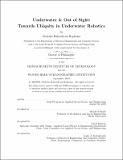| dc.contributor.advisor | Henrik Schmidt. | en_US |
| dc.contributor.author | Rypkema, Nicholas Rahardiyan. | en_US |
| dc.contributor.other | Joint Program in Applied Ocean Science and Engineering. | en_US |
| dc.contributor.other | Massachusetts Institute of Technology. Department of Electrical Engineering and Computer Science. | en_US |
| dc.contributor.other | Woods Hole Oceanographic Institution. | en_US |
| dc.date.accessioned | 2020-03-09T18:58:47Z | |
| dc.date.available | 2020-03-09T18:58:47Z | |
| dc.date.copyright | 2019 | en_US |
| dc.date.issued | 2019 | en_US |
| dc.identifier.uri | https://hdl.handle.net/1721.1/124118 | |
| dc.description | This electronic version was submitted by the student author. The certified thesis is available in the Institute Archives and Special Collections. | en_US |
| dc.description | Thesis: Ph. D., Joint Program in Applied Ocean Science and Engineering (Massachusetts Institute of Technology, Department of Electrical Engineering and Computer Science; and the Woods Hole Oceanographic Institution), 2019 | en_US |
| dc.description | Cataloged from student-submitted PDF version of thesis. | en_US |
| dc.description | Includes bibliographical references (pages 261-277). | en_US |
| dc.description.abstract | The Earth's oceans holds a wealth of information currently hidden from us. Eective measurement of its properties could provide a better understanding of our changing climate and insights into the creatures that inhabit its waters. Autonomous underwater vehicles (AUVs) hold the promise of penetrating the ocean environment and uncovering its mysteries; and progress in underwater robotics research over the past three decades has resulted in vehicles that can navigate reliably and operate consistently, providing oceanographers with an additional tool for studying the ocean. Unfortunately, the high cost of these vehicles has stied the democratization of this technology. We believe that this is a consequence of two factors. Firstly, reliable navigation on conventional AUVs has been achieved through the use of a sophisticated sensor system, namely the Doppler velocity log (DVL)-aided inertial navigation system (INS), which drives up vehicle cost, power use and size. | en_US |
| dc.description.abstract | Secondly, deployment of these vehicles is expensive and unwieldy due to their complexity, size and cost, resulting in the need for specialized personnel for vehicle operation and maintenance. The recent development of simpler, low-cost, miniature underwater robots provides a solution that mitigates both these factors; however, removing the expensive DVL-aided INS means that they perform poorly in terms of navigation accuracy. We address this by introducing a novel acoustic system that enables AUV self-localization without requiring a DVL-aided INS or on-board active acoustic transmitters. We term this approach Passive Inverted Ultra-Short Baseline (piUSBL) positioning. The system uses a single acoustic beacon and a time-synchronized, vehicle-mounted, passive receiver array to localize the vehicle relative to this beacon. | en_US |
| dc.description.abstract | Our approach has two unique advantages: first, a single beacon lowers cost and enables easy deployment; second, a passive receiver allows the vehicle to be low-power, low-cost and small, and enables multi-vehicle scalability. Providing this new generation of small and inexpensive vehicles with accurate navigation can potentially lower the cost of entry into underwater robotics research and further its widespread use for ocean science. We hope that these contributions in low-cost underwater navigation will enable the ubiquitous and coordinated use of robots to explore and understand the underwater domain. | en_US |
| dc.description.statementofresponsibility | by Nicholas Rahardiyan Rypkema. | en_US |
| dc.format.extent | 277 pages | en_US |
| dc.language.iso | eng | en_US |
| dc.publisher | Massachusetts Institute of Technology | en_US |
| dc.rights | MIT theses are protected by copyright. They may be viewed, downloaded, or printed from this source but further reproduction or distribution in any format is prohibited without written permission. | en_US |
| dc.rights.uri | http://dspace.mit.edu/handle/1721.1/7582 | en_US |
| dc.subject | Joint Program in Applied Ocean Science and Engineering. | en_US |
| dc.subject | Electrical Engineering and Computer Science. | en_US |
| dc.subject | Woods Hole Oceanographic Institution. | en_US |
| dc.subject.lcsh | Ocean. | en_US |
| dc.subject.lcsh | Submersibles. | en_US |
| dc.subject.lcsh | Robotics. | en_US |
| dc.subject.lcsh | Sound. | en_US |
| dc.subject.lcsh | Navigation. | en_US |
| dc.title | Underwater & out of sight : towards ubiquity in underwater robotics | en_US |
| dc.title.alternative | Underwater and out of sight | en_US |
| dc.title.alternative | Towards ubiquity in underwater robotics | en_US |
| dc.type | Thesis | en_US |
| dc.description.degree | Ph. D. | en_US |
| dc.contributor.department | Joint Program in Applied Ocean Science and Engineering | en_US |
| dc.contributor.department | Massachusetts Institute of Technology. Department of Electrical Engineering and Computer Science | en_US |
| dc.contributor.department | Woods Hole Oceanographic Institution | en_US |
| dc.identifier.oclc | 1142630448 | en_US |
| dc.description.collection | Ph.D. Joint Program in Applied Ocean Science and Engineering (Massachusetts Institute of Technology, Department of Electrical Engineering and Computer Science; and the Woods Hole Oceanographic Institution) | en_US |
| dspace.imported | 2020-03-09T18:58:46Z | en_US |
| mit.thesis.degree | Doctoral | en_US |
| mit.thesis.department | EECS | en_US |
